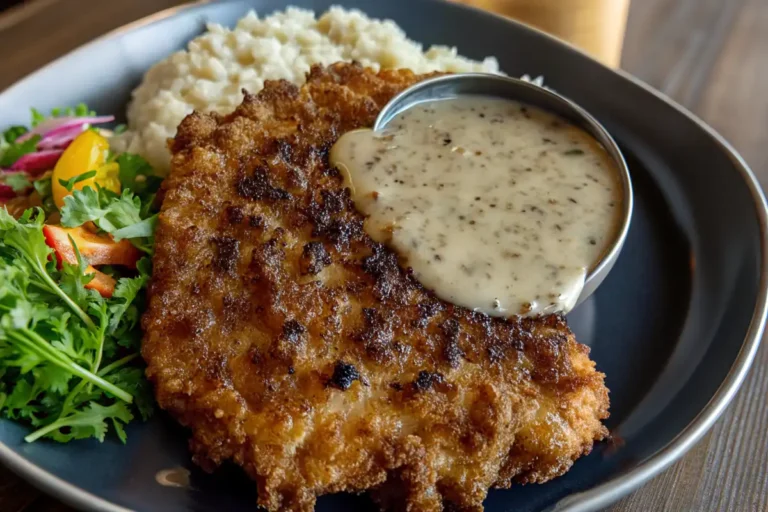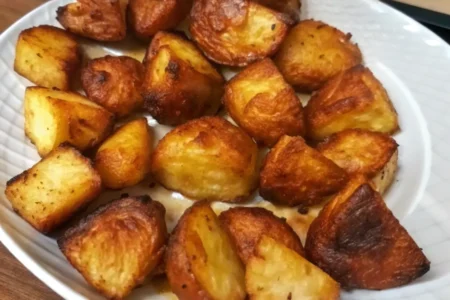It started with a craving and ended with country-style glory.
One Saturday morning, I woke up with a powerful, borderline spiritual craving for Southern comfort food. Not just any comfort food—chicken fried steak with country gravy, the kind you see in diners with red vinyl booths and mugs of watery coffee. Only I didn’t want to sit under fluorescent lighting next to a couple arguing about pickleball. I wanted to make it myself. From scratch. In my backyard. With questionable equipment and a whole lot of ambition.
Little did I know, this would become a mini pilgrimage—a journey through old-school techniques, meat mallets, hot oil, and a personal reckoning about gravy thickness.
The Not-So-Glamorous History of Chicken Fried Steak
Before we dive into the sizzling details, let’s talk about what this dish actually is. Chicken fried steak is a breaded, fried cube steak, usually drowned in a creamy white gravy. It’s like a deep-fried love letter to the American South, but oddly enough, it likely came from German immigrants who brought their schnitzel-making ways to Texas.
Imagine crossing Wiener Schnitzel with a plate of biscuits and gravy. That’s the vibe.
In fact, Texas is so proud of it that they made it the state dish in certain food festivals. You’ll find it at state fairs, rodeos, truck stops—and, if you’re lucky, in a pan sizzling away on your friend’s grill.
Step-by-Step: My Backyard Version of Chicken Fried Steak
Choosing the Right Cut of Meat
You can’t use fancy cuts here. That’s part of the charm. Cube steak—thin, already tenderized beef—is the go-to. It’s usually from the round and already passed through a mechanical tenderizer. But if you only have eye of round, no worries. Just beat the living daylights out of it with a meat mallet (or the back of a cast iron skillet if you’re feeling wild).
The Dredging Station
This was the holy trinity of coatings:
- Dry Bowl: All-purpose flour, smoked paprika, garlic powder, and a little corn starch (the secret to extra crispy breading). I also tossed in some salt and pepper.
- Wet Bowl: Buttermilk, two eggs, and a big splash of hot sauce. Not just for spice—it adds tang and makes the batter wake up a bit.
- Then back to the dry. This double-dip method ensures that golden, crackly coating that sings when you slice through it.
Pro tip: Season each layer. Bland meat wrapped in seasoned crust is still bland meat. Put some soul in it.
Deep-Fried Drama (And a Few Close Calls)
I used a cast iron skillet over a grill, because nothing says backyard culinary chaos like open flame and bubbling oil. The goal was 350°F, but let’s be honest, it hovered between 345° and 370°, depending on wind, my attention span, and whether my dog knocked over the thermometer.
I fried each steak about 4-5 minutes per side, until they were golden and audibly crispy. If it doesn’t crunch when you cut it, start over.
Let’s Talk Gravy
I poured off most of the frying oil, leaving just a couple of tablespoons of the good, seasoned stuff. Tossed in a few tablespoons of the leftover dredge flour, whisked it into a roux, and slowly added whole milk until I got a gravy that could hold its shape but still pour.
Here’s where the controversy begins.
Some folks want their gravy thin and sassy. Others like it thick enough to mortar bricks. I fall in the middle. A gravy that flows slowly and luxuriously, like a Southern drawl.
Tons of black pepper. Maybe a pinch of cayenne. You taste it and immediately think of Sunday supper at grandma’s.
Around the World in Breaded Beef
Believe it or not, this idea of battered, fried beef with gravy isn’t unique to the South.
- In Austria, Wiener Schnitzel is the spiritual cousin—veal, not beef, and served with lemon.
- Japan has katsu, often pork or chicken, with a sweet-savory sauce.
- Even in Argentina, milanesa reigns supreme, thin-sliced meat breaded and fried, sometimes topped with an egg.
It’s the same soul in a different outfit. But none of them drown it in white pepper gravy, and that’s where we Americans go full drama queen.
Why You Should Try This At Least Once
There’s something grounding about this recipe. You take humble ingredients and basic techniques and end up with something that tastes like home, warmth, and rebellion against kale.
It’s also a great excuse to gather people. Make a mess. Pour drinks. Let someone else do dishes. Plus, it makes you feel like you’ve inherited a culinary secret passed down through generations of grandmas who never measured anything.
And for what it’s worth? I cut into that steak and it crunched like fall leaves. The gravy hugged the meat like a wool sweater. I felt like a Southern auntie who keeps hot sauce in her purse.
Tips From the Trenches
- Don’t overcrowd the pan. Unless you want soggy crust.
- Use half-and-half if you want your gravy extra rich.
- Add a splash of pickle juice to your wet mix. Trust me.
- Let the steak rest before drowning it in gravy—it helps the crust stay crisp.
The Chicken Fried Steak Olympics (Yes, It’s a Thing)
Texas holds annual cook-offs where people compete to make the best chicken fried steak. Some bring custom fryers. Others bring their grandmas. It’s intense.
One year, someone used elk. Another time, there was a vegan version made with battered cauliflower and coconut milk gravy. Look, I’m not saying it tasted bad. I’m saying it tasted like betrayal.
The Final Verdict: Worth Every Splatter
Sure, my porch smelled like a Cracker Barrel parking lot. My fingers were covered in flour paste. And I think my dog is traumatized by the sound of popping oil.
But would I do it again? Absolutely. Because nothing—and I mean nothing—tastes as good as homemade chicken fried steak with creamy country gravy, eaten standing over the stove, burning your mouth because you can’t wait.







